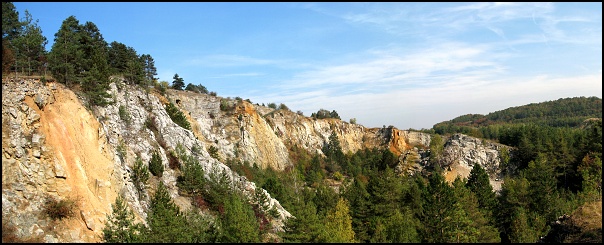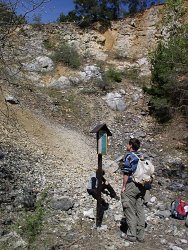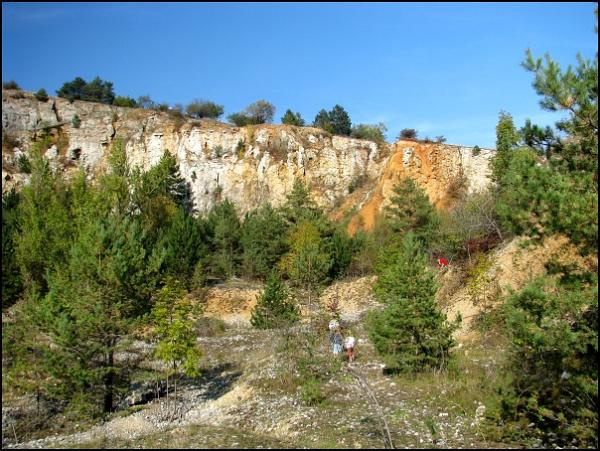
Protoze tentokrat je listing velice obsahly,
podminky k logovani jsou tady hned na zacatku.
K zalogovani splnte nasledujici - najdete na
souradnicich 49°54.847 014°03.902 informacni tabuli a vyhledejte
odpovedi na otazky:
1) Jak stary je Koneprusky utes?
2) Kolik druhu zivocichu zde bylo popsano?
3) Jaka byla skutecna velikost Lioharpes venulosus? (na tabuli je
obrazek, pokud tam neni, jste u spatne cedule a zaskocte si na
souradnice o par radku vyse :))
a samozrejme prilozte vase foto / nebo vasi GPSky s tabuli v lomu
pripadne vasich nalezu. |

zdroj www.paleontologie.cz |
Sice na lokalitu posledni roky dochazi vic a vic lidi, ale stale se
zkameneliny najdou. Jen doporucujeme vzit si aspon obycejne
kladivko - lepe geologicke s ostrou spickou - at muzete nektere
nadejne kousky kamenu rozbit.
Zkameneliny / Fosilie
(z latinského fossus, doslova "byt vykopan")
V sirsim slova smyslu jsou slovem fosilie oznacovany zkamenele i
nezkamenele zbytky a otisky jinych nez recentnich organismu. Casto
se za fosilie povazuji take stopy po cinnosti techto organismu,
ktere se odborne nazyvaji bioglyfy, jsou to otisky koncetin, nebo
jen drobne dirky po vrtani ci cesticky po lezeni.
Zkameneni je mimoradne vzacny vyskyt, protoze vetsina casti tel
odumrelych zivocichu a rostlin ma tendenci se rozkladat pomerne
rychle po smrti. K tomu, aby organismus „zkamenel“
zustava zpravidla nutne, aby byl pokryt usazeninami co nejdrive po
smrti. (Existuji i drobne vyjimky, napriklad pokud organismus
zmrzne, vysusi se, nebo se ocitne v prostredi bez pristupu
kysliku.)
Proces fosilizace muze mit ruzny prubeh, ktery je vsak zasadni a
odrazi se v mire zachovalosti fosilie.
Fosilizacni proces jako soubor slozitych dilcich procesu vede k
ruznemu, kvalitativne odlisnemu, uchovani fosilnich organizmu.
Podle zpusobu zachovani rozdelujeme fosilie na dve skupiny:
1. fosilie prave - v jejich slozeni nedoslo k podstatnym zmenam v
dusledku fosilizacnich a diagenetickych procesu. Uchovavaji se bud'
nezmenene schranky (napr. schranky mekkysu), zuby obratlovcu (diky
velice odolnemu dentinu) nebo se dochovava i mekka tkan zivocichu
vysusenim v aridnim prostredi nebo v dynamickem prostredi jeskyni
(takto dochovane zbytky se oznacuji jako mumie). Jako pseudomumie
se oznacuji zivocichove zachovani i s mekkou tkani pusobenim
extremne nizkych teplot. Pseudomumie mohou vznikat i v prostredi
bazin, ozokeritovych akumulaci, zivicnych latek, evaporitu.
2. fosilie v sirsim slova smyslu - u takto zachovanych fosilii
doslo k nahrazeni jejich puvodnich schranek nebo tkani jinou
mineralni latkou, a to dokonce i opakovane (puvodne pyriticke
fosilie mohou v oxidacnich podminkach prejit na limonitizovane
atd.).
a) jadro - sediment vyplnuje vnitrni prostor schranky. Na vnejsim
povrchu jadra (take se oznacuje jako kamenne jadro) se otiskuji
vnitrni struktury schranky (svalove vtisky, otisky plaste,
vaskularni system ap.). Sediment muze vyplnit cely vnitrni prostor
schranky, jadro se pak oznacuje jako jadro uplne, v opacnem pripade
nedojde k vyplneni cele schranky (sedimentu stoji v ceste napr.
prepazky ve fragmokonu u hlavonozcu) a vznika jadro neuplne.
Rozpoustela-li se schranka v nezpevnenem sedimentu a na povrchu
jadra se otiskne skulptura povrchu schranky (sediment je v
hydroplastickem stavu), pak tento zpusob zachovani se nazyva jadro
skulpturni. Nekdy (u plochych krunyru trilobitu) se na povrchu
jejich jader prolinaji struktury jadra vnitrniho i struktury
povrchu krunyre a vznika jadro slozene.
b) otisk - znazornuje charakter vnejsiho povrchu organizmu, napr.
zachovaneho jako jadro. Jedna se tedy o protiotisk (utvar
konkavni). Z ciste deskriptivniho hlediska se otisk oznacuje jako
negativ a jadro (ci zachovana schranka) jako pozitiv (ma konvexni
relief).
c) vylitek - jedna se o jadro v sirsim slova smyslu. Po vytvoreni
jadra (vnitrniho) a po rozpusteni schranky vznikne mezi jadrem a
protiotiskem dutina. Jestlize se vyplni sedimentem nebo
fosilizacnim mineralem vznikne vylitek.
d) odlitek - vznikne vyplnenim dutiny po schrance i jejiho
vnitrniho prostoru.
(www.wikipedia.org, geologie.vsb.cz)

Lokalita Houbuv lom
Houbuv lom je stary zruseny romanticky lom na jizni strane navrsi
Zlateho kone, ktere je jednou z nejbohatsich svetovych
paleontologickych lokalit ve spodnim devonu. Bylo zde popsano pres
500 druhu zivocichu. Devonske vrstvy tvori v jiznim okoli Koneprus
rozsahlou plochou synklinalu, jejiz jadro s nejmladsimi vrstvami
lezi prave v oblasti Zlateho kone. Severni ohraniceni synklinaly je
tektonicke, podel tzv. ockovskeho presmyku byly na pevny masiv
konepruskych a nadloznich vapencu nasunuty od severu starsi
spodnodevonske a silurske vrstvy.
V Houbove lomu jsou odkryty polohy konepruskych vapencu a nadlozni
suchomastske vapence. Konepruske vapence vznikaly v tropickem mori
asi pred 400 miliony let. Vyznacuji se belavym zbarvenim a masivnim
charakterem bez patrne vrstevnatosti. Na Zlatem koni tvori typicky
utes, v nemz lze rozeznat dva hlavni geneticke typy vapencu –
biogenni a biodetriticke. Biogenni vapence vznikly aktivni
utesotvornou cinnosti prisedlych organismu, hlavne vapnitych ras,
stromatopor, lilijic, koralu aj. Tyto vapence predstavuji vlastni
jadro utesu. Do Houbova lomu zasahuji biogenni vapence jen
prstovite, vlastni centrum utesu lezelo severneji a je vyborne
odkryto ve vychodni stene tzv. Cisarskeho lomu na Zlatem koni.
Biodetriticke vapence predstavuji jednak drt, ktera vznikla
rozrusovanim utesu cinnosti vln i organismu, jednak nahromadene
zbytky tech organismu, ktere v tesne blizkosti utesu a na jeho
svazich nalezaly nejvhodnejsi zivotni podminky. Byli to zejmena
ramenonozci, mechovky, korali, plzi aj. Tyto vapence vyplnovaly
nerovnosti utesu a tvorily kolem pevneho jadra mohutne osypy,
jejichz celkovy objem podstatne prevysuje podil vapencu
biolitickych. Odkryvy techto vapencu s hojnymi fosiliemi se
nachazeji na Zlatem koni v Houbove lomu. Konepruske vapence
obsahuji velmi hojnou faunu, reprezentujici vetsinu zastupcu v te
dobe zijicich zivocisnych skupin. K nejhojnejsim zkamenelinam patri
lilijice, ramenonozci (popsano kolem 100 druhu), mechovky, korali,
stromatopory, plzi (popsano pres 100 druhu), mlzi, mekkysi,
trilobiti (popsano pres 50 druhu) aj. Fauna konepruskych vapencu
mimo konepruskou oblast je pomerne chuda.
(www.otevrena-veda.cz)
zajimavost: Pokud se uprostred lomu - souradnice kese -
zadivate na severni stenu lomu, uvidite nahore otvor, kterym byly
roku 1950 (znovu)objeveny Konepruske jeskyne - nejvetsi jekynni
komplex v Cechach. Ale to uz je tema jine Earthcache.
pristup: Do Houbova lomu se pohodlne dostanete z parkoviste
Konepruskych jeskyni - polni cesta z jihozapadniho rohu parkovaci
plochy - cca 600m. A mene pohodlne - od vychodu z Konepruskych
jeskyni na zapad a pak cesticce dolu podel dreveneho zabradli nad
severozapdni a zapadni stenou lomu.
EN: Fossils
-------
Fossils (from Latin fossus, literally "having been dug up") are the
preserved remains or traces of animals, plants, and other organisms
from the remote past. The totality of fossils, both discovered and
undiscovered, and their placement in fossiliferous
(fossil-containing) rock formations and sedimentary layers (strata)
is known as the fossil record. The study of fossils across
geological time, how they were formed, and the evolutionary
relationships between taxa (phylogeny) are some of the most
important functions of the science of paleontology. Such a
preserved specimen is called a "fossil" if it is older than some
minimum age, most often the arbitrary date of 10,000 years ago.
Hence, fossils range in age from the youngest at the start of the
Holocene Epoch to the oldest from the Archaean Eon several billion
years old. The observations that certain fossils were associated
with certain rock strata led early geologists to recognize a
geological timescale in the 19th century. The development of
radiometric dating techniques in the early 20th century allowed
geologists to determine the numerical or "absolute" age of the
various strata and thereby the included fossils.
Like extant organisms, fossils vary in size from microscopic, such
as single bacterial cells only one micrometer in diameter, to
gigantic, such as dinosaurs and trees many meters long and weighing
many tons. A fossil normally preserves only a portion of the
deceased organism, usually that portion that was partially
mineralized during life, such as the bones and teeth of
vertebrates, or the chitinous exoskeletons of invertebrates.
Preservation of soft tissues is rare in the fossil record. Fossils
may also consist of the marks left behind by the organism while it
was alive, such as the footprint or feces (coprolites) of a
reptile. These types of fossil are called trace fossils (or
ichnofossils), as opposed to body fossils. Finally, past life
leaves some markers that cannot be seen but can be detected in the
form of biochemical signals; these are known as chemofossils or
biomarkers.
Fossilization is an exceptionally rare occurrence, because most
components of formerly-living things tend to decompose relatively
quickly following death. In order for an organism to be fossilized,
the remains normally need to be covered by sediment as soon as
possible. However there are exceptions to this, such as if an
organism becomes frozen, desiccated, or comes to rest in an anoxic
(oxygen-free) environment. There are several different types of
fossils and fossilization processes.
Due to the combined effect of taphonomic processes and simple
mathematical chance, fossilization tends to favor organisms with
hard body parts, those that were widespread, and those that existed
for a long time before going extinct. On the other hand, it is very
unusual to find fossils of small, soft bodied, geographically
restricted and geologically ephemeral organisms, because of their
relative rarity and low likelihood of preservation.
Larger specimens (macrofossils) are more often observed, dug up and
displayed, although microscopic remains (microfossils) are actually
far more common in the fossil record.
Some casual observers have been perplexed by the rarity of
transitional species within the fossil record. The conventional
explanation for this rarity was given by Darwin, who stated that
"the extreme imperfection of the geological record," combined with
the short duration and narrow geographical range of transitional
species, made it unlikely that many such fossils would be found.
Simply put, the conditions under which fossilization takes place
are quite rare; and it is highly unlikely that any given organism
will leave behind a fossil. Eldredge and Gould developed their
theory of punctuated equilibrium in part to explain the pattern of
stasis and sudden appearance in the fossil record. Furthermore, in
the strictest sense, nearly all fossils are "transitional," due to
the improbability that any given fossil represents the absolute
termination of an evolutionary path.
Types of preservation:
1) Permineralization
Permineralization occurs after burial, as the empty spaces within
an organism (spaces filled with liquid or gas during life) become
filled with mineral-rich groundwater and the minerals precipitate
from the groundwater, thus occupying the empty spaces. This process
can occur in very small spaces, such as within the cell wall of a
plant cell. Small scale permineralization can produce very detailed
fossils. For permineralization to occur, the organism must become
covered by sediment soon after death or soon after the initial
decaying process. The degree to which the remains are decayed when
covered determines the later details of the fossil. Some fossils
consist only of skeletal remains or teeth; other fossils contain
traces of skin, feathers or even soft tissues. This is a form of
diagenesis.
2) Casts and molds
In some cases the original remains of the organism have been
completely dissolved or otherwise destroyed. When all that is left
is an organism-shaped hole in the rock, it is called an external
mold. If this hole is later filled with other minerals, it is a
cast. An internal mold is formed when sediments or minerals fill
the internal cavity of an organism, such as the inside of a bivalve
or snail.
3) Replacement and recrystallization
Replacement occurs when the shell, bone or other tissue is replaced
with another mineral. In some cases mineral replacement of the
original shell occurs so gradually and at such fine scales that
microstructural features are preserved despite the total loss of
original material. A shell is said to be recrystallized when the
original skeletal compounds are still present but in a different
crystal form, as from aragonite to calcite.
4) Compression fossils
Compression fossils, such as those of fossil ferns, are the result
of chemical reduction of the complex organic molecules composing
the organism's tissues. In this case the fossil consists of
original material, albeit in a geochemically altered state. Often
what remains is a carbonaceous film. This chemical change is an
expression of diagenesis.
5) Bioimmuration
Bioimmuration is a type of preservation in which a skeletal
organism overgrows or otherwise subsumes another organism,
preserving the latter, or an impression of it, within the skeleton.
Usually it is a sessile skeletal organism, such as a bryozoan or an
oyster, which grows along a substrate, covering other sessile
encrusters. Sometimes the bioimmured organism is soft-bodied and is
then preserved in negative relief as a kind of external mold. There
are also cases where an organism settles on top of a living
skeletal organism which grows upwards, preserving the settler in
its skeleton. Bioimmuration is known in the fossil record from the
Ordovician to the Recent.
To sum up, fossilization processes proceed differently for
different kinds of tissues and under different kinds of
conditions.
(www.wikipedia.org)
------
Fossil Site Houbuv Lom
Houbuv Lom (Houba Quarry) is old romantic abandoned quarry at the
side of Zlaty kun (Golden Horse hill). It is one of the richest
palaeontological sites from the Lower Devonian period in the world
and more than 500 animal species have been recorded here. To the
south of Koneprusy the Devonian layers form an extensive flat
syncline, the core of which contain the youngest layers lie in the
Zlatý kun area. The northern edge of this syncline is of tectonic
origin and runs along the Ockov reverse slip-fault, where older
Lower Devonian and Silurian limestones were thrust from the north
to lay on top of the firm Koneprusy Massif and the overlaying
limestones.
Positions of Koneprusy limestones and the overlying Suchomasty
limestone are exposed in the Houba Quarry. Koneprusy limestone was
formed in a tropical sea around 400 million years ago, and is
characterized by its bleached white appearance and massive
structure without apparent layering. At Zlaty kun this limestone
forms a typical reef, in which we can recognize the two main
genetic types of limestone – biogenic and biodetritic.
Biogenic limestone was formed by active reef-building activity of
static organisms especially calcareous algae seaweeds,
stromatopores, sea-lilies, corals etc. These limestones represent
the core of the reef. Biogenic limestones only reach into the
Houbuv lom Quarry in a finger-like manner as the centre of the reef
lay further to the north, where it is very clearly exposed in the
eastern wall of the Cisarsky lom Quarry at Zlaty kun Hill.
Biodetritic limestone is built of grit (detritus) which was broken
away from the reef by wave action, and also of collections of the
remains of animals which found their most suitable conditions on
the slopes around the reef and died there. These were predominantly
brachiopods, false corals, corals, gastropods etc. These limestones
filled in the gaps in the reef and formed massive banks around the
firm core of the reef. The total volume of this type is far greater
than, the volume of “core” limestone. These limestone
types with an abundance of fossils can be seen at the Houba Quarry
on Zlaty kun Hill. The Koneprusy limestone is extremely rich in
fossils with representatives of most of the animal groups which
lived at that time. The most abundant fossils are the sea-lilies,
brachiopods (around 100 species recorded), clams, molluscs,
trilobites (more than 50 species recorded), false corals, corals,
stromatopores etc. The fauna content of the Koneprusy limestone
outside of the Koneprusy area is relatively poor.
(www.otevrena-veda.cz)
---
Further interesting information: at the northen quarry's rock wall
upword you can see original big hole, through which were in 1950
discovered Koneprusy caves - the largest cave system in
Bohemia.
--------
To the quarry you can easy walk the path 600 meters from Koneprusy
cave parking - southwest direction.
-------
To log the earthcache, find information board of
the site (49°54.847 014°03.902) and answer the questions:
1) How old is Koneprusy reef?
2) How many species were found at the site?
3) What was a real size of Lioharpes venulosus?
and upload photo with you (or your gps, if you are too shy ;)) and
the board. |

zdroj www.paleontologie.cz |